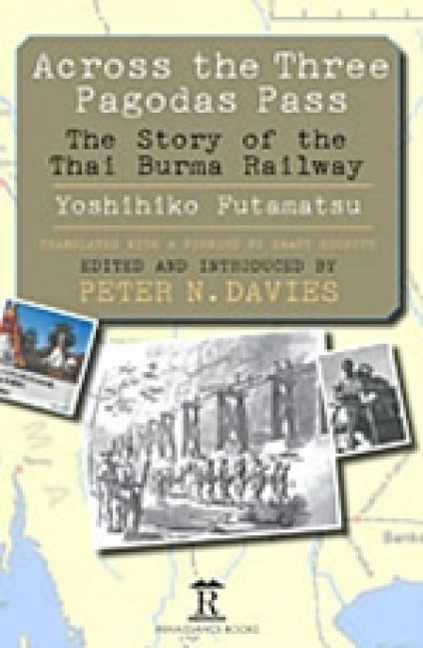Book contents
- Frontmatter
- Dedication
- Contents
- Acknowledgements
- Foreword
- Introduction
- Across the Three Pagodas Pass
- Translator’s Acknowledgements
- Preface
- Chapter 1 Departure for the Front
- Chapter 2 In Indo-China
- Chapter 3 Opening of Hostilities
- Chapter 4 The River Krian
- Chapter 5 The Malayan Campaign
- Chapter 6 The Fall of Singapore
- Chapter 7 Surrender
- Chapter 8 Shōnan: Light of the South
- Chapter 9 The Thai-Burma Railway
- Chapter 10 Preparing Construction
- Chapter 11 Banpong
- Chapter 12 Prisoners-of-War
- Chapter 13 Constructing the Railway
- Chapter 14 Thailand
- Chapter 15 The River Kwae Noi
- Chapter 16 The Mae Khlaung Bridge
- Chapter 17 Kanchanaburi
- Chapter 18 The Jungle
- Chapter 19 From Bangkok to Singapore
- Chapter 20 Rush Construction
- Chapter 21 The Base at Wanyai
- Chapter 22 The Labour Force
- Chapter 23 Survey Unit
- Chapter 24 Test Run
- Chapter 25 Bridge-Building and Shifting Earth
- Chapter 26 The Rainy Season: The Monsoon
- Chapter 27 Kinsaiyok
- Chapter 28 Diseases and Epidemics
- Chapter 29 Cattle Drive
- Chapter 30 Living in the Jungle
- Chapter 31 Soon to the Three Pagodas Pass
- Chapter 32 Towards the Setting Sun
- Chapter 33 Opening to Traffic
- Chapter 34 The Bombing
- Chapter 35 End of the War
- Chapter 36 Internment
- Chapter 37 Repatriation
- Footnote
- Postscript
- End Notes
- Glossary
- Bibliography
- Index
Chapter 26 - The Rainy Season: The Monsoon
Published online by Cambridge University Press: 13 May 2022
- Frontmatter
- Dedication
- Contents
- Acknowledgements
- Foreword
- Introduction
- Across the Three Pagodas Pass
- Translator’s Acknowledgements
- Preface
- Chapter 1 Departure for the Front
- Chapter 2 In Indo-China
- Chapter 3 Opening of Hostilities
- Chapter 4 The River Krian
- Chapter 5 The Malayan Campaign
- Chapter 6 The Fall of Singapore
- Chapter 7 Surrender
- Chapter 8 Shōnan: Light of the South
- Chapter 9 The Thai-Burma Railway
- Chapter 10 Preparing Construction
- Chapter 11 Banpong
- Chapter 12 Prisoners-of-War
- Chapter 13 Constructing the Railway
- Chapter 14 Thailand
- Chapter 15 The River Kwae Noi
- Chapter 16 The Mae Khlaung Bridge
- Chapter 17 Kanchanaburi
- Chapter 18 The Jungle
- Chapter 19 From Bangkok to Singapore
- Chapter 20 Rush Construction
- Chapter 21 The Base at Wanyai
- Chapter 22 The Labour Force
- Chapter 23 Survey Unit
- Chapter 24 Test Run
- Chapter 25 Bridge-Building and Shifting Earth
- Chapter 26 The Rainy Season: The Monsoon
- Chapter 27 Kinsaiyok
- Chapter 28 Diseases and Epidemics
- Chapter 29 Cattle Drive
- Chapter 30 Living in the Jungle
- Chapter 31 Soon to the Three Pagodas Pass
- Chapter 32 Towards the Setting Sun
- Chapter 33 Opening to Traffic
- Chapter 34 The Bombing
- Chapter 35 End of the War
- Chapter 36 Internment
- Chapter 37 Repatriation
- Footnote
- Postscript
- End Notes
- Glossary
- Bibliography
- Index
Summary
In Thailand, Malaya and other countries in the South-East-Asia region, a round of sudden squalls of rain falls every day. Out of a clear sky it suddenly becomes misty, one expects big drops of rain to fall, it becomes a cloudburst. It sweeps everything away in its fall, but after some ten minutes it stops. The clouds clear off and with sunlight filling the neighbourhood the temperature rises, pools on the ground soon dry up before one's very eyes. Such squalls become frequent, intervals between them brief, it seems to go on pouring in a series of rainstorms. Such is the rainy season.
The rainy season in the Thailand-Burma regions usually lasts from May until the end of August, In Japan it lasts a long time so the volume of rain there is large. Particularly in the Three Pagodas Pass region the rainfall in this Tenanasserim belt approaches the world's heaviest rainfall of over 200 ml a day, with occasional rare cloudbursts with 100 ml falling within an hour. In some months a total of 2,000 ml is reached; in Japan this equals a year's average rainfall. In the dry season there were no cloudy skies and the way it cleared up was a marvel. The rainy season was also called the period of monsoons.
When the rainy season opened the surface-drainage of the roads became bad, rainwater accumulated, it got very muddy. Cars had their wheels trapped in quagmires, unable to move. Automobile accidents often piled up and in the end it became extremely difficult to get through at all. Over the deep ruts even bullock-carts with their wide diameter wheels could barely get through. The engineers could move on foot only. Prisoners-of-war and coolies moved blindly on from Kamburi to Wanyai and from Wanyai to Kinsaiyok carrying their heavy baggage, trudging on, soaked by the rain. In single file they stumbled on all mixed together, engineers, prisoners, coolies, Japanese troops aiming at the frontier. These troops carried stripped-down mountain-guns and heavy machine-guns on their shoulders, trudging on in silence carrying equipment-parts on their backs.
- Type
- Chapter
- Information
- Across the Three Pagodas PassThe Story of the Thai-Burma Railway, pp. 122 - 126Publisher: Amsterdam University PressPrint publication year: 2013



